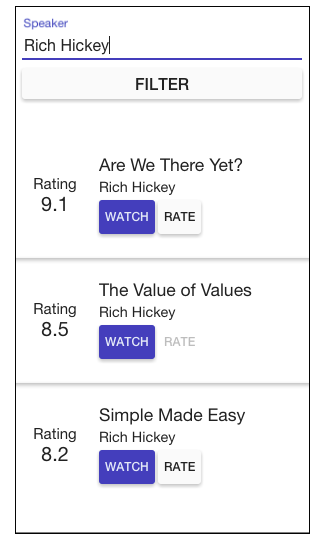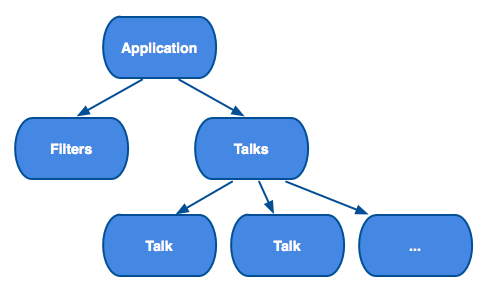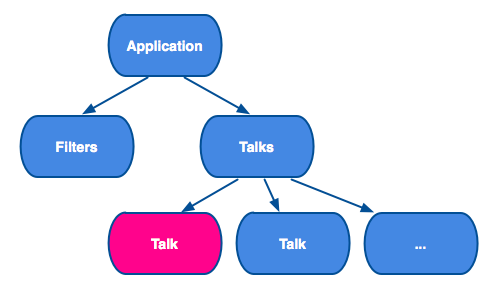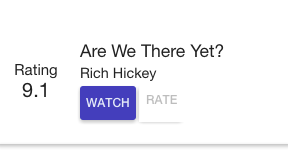TWO PHASES OF ANGULAR 2 APPLICATIONS
Angular 2 separates updating the application model and reflecting the state of the model in the view into two distinct phases. The developer is responsible for updating the application model. Angular, by means of change detection, is responsible for reflecting the state of the model in the view. The framework does it automatically on every VM turn.
Event bindings, which can be added using the () syntax, can be used to capture a browser event execute some function on a component. So they trigger the first phase. In addition, Angular provides the Form module as a replacement for ng-model.
Property bindings, which can be added using the [] syntax, should be used only for reflecting the state of the model in the view (view state propagation).
EXAMPLE
Let’s look at an example showing the two phases. What we have here is a simple application with a list of tech talks, which you can filter, watch, and rate.

An Angular 2 application consists of nested components. So an Angular 2 application will always have a component tree. Let’s say for this app it looks as follows:

Finally, let’s define the application model that will store the state of our application:
{
filters: {speakers: "Rich Hickey"},
talks: [
{
id:898,
title: "Are we there yet",
speaker: "Rich Hickey",
yourRating:null,
rating: 9.1
},
...
]
}
Now, imagine an event changing the model. Let’s say I watched the talk “Are we there yet”, I really liked it, and I decided to give it 9.9.
The code snippet below illustrates one way to do it. The handleRate function is called when the user rates a talk. The Talk component just delegates to the App object that updates the model.
@Component({
selector: "talk",
bind: {talk: "talk"}
})
@Template({url: "talk.html"})
// render a talk object
class TalkComponent {
talk:Talk;
constructor(private app:App){}
handleRate(yourRating:number) {
this.app.rateTalk(talk, yourRating);
}
}
@Component({selector: "talks"})
@Template({url: "talks.html"})
//renders a list of talks
class TalksComponent {
talks:List;
constructor(mb:MessageBus) {
mb.onChange((updateModel) => this.talks = updatedModel.get("talks"));
}
}
// contains the business logic
class App {
model:Map;
constructor(private messageBus:MessageBus){}
rateTalk(talk:Talk, rating:number){
// model is immutable, so we have to construct a new model object
var updatedTalk = updateRecord(talk, {rating});
var updatedTalks = this.model.get("talks").replace(talk.id, updatedTalk);
this.model = this.model.set("talks", updatedTalks);
this.messageBus.emit("change", this.model);
}
}
This example is written using TypeScript 1.5 that supports type and metadata annotations, but it can be easily written in ES6 or ES5. You can find more information on annotations here https://docs.google.com/document/d/1uhs-a41dp2z0NLs-QiXYY-rqLGhgjmTf4iwBad2myzY/edit.
The updated model looks like this:
{
filters: {speakers: "Rich Hickey"},
talks: [
{
id:898,
title: "Are we there yet",
speaker: "Rich Hickey",
yourRating: 9.9,
rating: 9.1
},
...
]
}
At this point nothing has changed in the view. The DOM has not been updated yet. The model is updated, but did not use property bindings or change detection.
Next, at the end of the VM turn, change detection kicks in to execute the view state propagation.
First, change detection goes through every component in the component tree to check if the model it depends on changed. And if it did, it will update the component. In this example, the first Talk component gets updated:

Then, the framework updates the DOM. In our example, the rate button gets disabled because you cannot rate the same talk twice.

Note, the framework has used change detection and property bindings to execute this phase.
In our example we are using global state and immutable data. But even if we used local state and mutable data, it would not change the property that the application model update and the view state propagation are separated. I will explain why this is important below.
HANDLING FORMS
Angular 2 comes with the Forms module, which is useful for handling input. Say, we have a component responsible for adding talks to our database. This is how we can build it using Forms:
@Template({
inline: `
<form [control-group]="form" (submit)="createTalk(form.value)">
Title: <input control="title">
Description: <textarea control=-"description"></textarea>
Save as draft: <input control="isDraft" type="checkbox">
<button type="Submit">Create</button>
</form>
`
})
class CreateTalkComponent {
constructor(b:FormBuilder, private app:App) {
this.form = b.group({
title: ["", required],
description: "",
isDraft: [false, required]
});
}
createTalk(talkData:
{title:string, description:string, isDraft:boolean}) {
this.app.createTalk(talkData);
}
}
First, we declare a form object in a component. In this example it has three fields: title, description and isDraft. The title and isDraft fields are required fields, and description can be blank. Then, we bind to this form in the component’s template and get the value of the form on submission. You can read more about Forms in Angular 2 in this blog post.
Why Forms instead of ng-model? Since the only purpose of change detection in Angular 2 is propagating the view state, the generic two-way data-binding mechanism, like the one in Angular 1, does not add much value. But it is the source of a lot of performance penalties. First, it is easy to misuse to mix the application model update and view state propagation. Second, is that it can create cycles in the change detection graph, which makes the system hard to reason about. That is why complex forms built with ng-model can be non-trivial to reason about.
We believe the Angular Forms module is easier to use and reason about than ng-model, it provides the same conveniences as ng-model, but does not have its drawbacks. We think it is a big improvement over ng-model. Also, to make the migration of Angular 1 apps easier, we are planning to implement the Forms module in Angular 1.
WHY?
Now, when we have understood how we separated the concerns, let’s look at why we did it.
PREDICTABILITY
First, using change detection for the view state propagation limits the number of places where the application model can be changed. In this example it can happen only in the rateTalk function. A watcher cannot “automagically” update it. This makes ensuring invariants, and in general, reasoning about your application model easier.
Second, our reasoning about the view state propagation has been drastically simplified. Consider what we can say about the Talk component just by looking at it in isolation. Since we use immutable data, we know that as long as we do not do talk= in the Talk component, the only way to change what the component displays is by updating the binding. These are strong guarantees that allow us to think about this component in isolation.
It is hard to achieve this kind of guarantee in Angular 1.x.. First, talk=new Talk() could potentially result in cascading changes if the talk were two-way bound to some property on the parent component. Second, since the Angular 1.x way of dealing with forms is to create an ng-model binding, it would be hard to keep Talk immutable.
Finally, by explicitly stating what the application and the framework are responsible for, we can set different constraints on each part. For instance, it is natural to have cycles in your application model. So the framework should support it. On the other hand, html forces components to form a tree structure. So we can model the change detection graph as a tree, which makes the system more predictable.
Let me give you one example. Can you tell which directive will be updated first: Parent or Child?
<parent prop1="exp1" prop2="exp2">
<child prop3="exp3" prop4="exp4"></child>
</parent>
In Angular 1.x the update can be interleaved. How many times prop1 is updated in the same digest run? It can more than 1. This makes implementing certain patterns very difficult. It also makes troubleshooting certain types of problems challenging: you just cannot reason about the template statically, you have to know how the model gets updated.
In Angular 2, you know that Parent will always be updated before Child, and we also know that a property cannot be updated more than once.
Angular 2 makes reasoning about the component easier because it limits the number of ways it can be modified, and makes this modification predictable.
PERFORMANCE
A big part of the separation is that it allows us to constrain the view state propagation. This makes the system more predictable, but it also makes it a lot more performant. For example, the fact that the change detection graph in Angular 2 can be modelled as a tree allowed us to get rid of digest TTL. Now the system gets stable after a single pass.
HOW DOES ANGULAR ENFORCE IT?
What happens if I try to break the separation? What if complect the two phases by changing the application model inside a setter that is invoked by the change detection system?
Angular tries to make sure that the setter you define for you component should only update the view state of this component or its children, and not the application model. To do that change detection will walk the graph twice in developer mode. First time to propagate changes, and second time to make sure there are no changes. If it finds a change during the second pass, it means that one of your setters updated the application model, the framework will throw an exception, giving you the feedback you need to ensure it runs properly in production.
WHAT ABOUT ANGULAR 1.X?
Although Angular 1.x was not built with this separation in mind, you can still write your code in this way to make your migration easier. Here’s a few things you can do:
- Prefer one-way data-bindings to two-way data-bindings.
- Do not update application state inside watch functions.
- Try to implement unidirectional data-flow in your application. Read more about it here.
SUMMARY
- Angular 2 separates updating the application model and the view state propagation.
- Event bindings trigger the application model update phase.
- Change detection uses property bindings to execute the view state propagation phase. The view state propagation is unidirectional and top-down. This makes the system a lot more predictable and performant.
- Angular 2 embraces unidirectional data-flow and provides the Angular Forms module instead of ng-model.
- You can use the same mindset when building Angular 1.x applications.
- Csaba Tamas • 16 days ago
Hy! Can You share the working full source code? It would be a great help for me, becasue I worked on Angular 2 POC and I can't how buld component hierarchy. I using only component-decorator tree like: yet: https://github.com/angular/ang...
Thanks!
 Victor Savkin Mod Csaba Tamas • 16 days ago
Victor Savkin Mod Csaba Tamas • 16 days agoThis would be one example: https://github.com/angular/ang.... More are coming.
 Jinto Jose • 14 days ago
Jinto Jose • 14 days agoNice post. Just a small doubt. AngularJS 2.0 is following the concepts which ReactJS is already having?
 Victor Savkin Mod Jinto Jose • 14 days ago
Victor Savkin Mod Jinto Jose • 14 days agoThank you. Glad you liked the post.
The idea of being more explicit about the data flow, in my opinion, is a good one. But I would not think about it as a feature or a capability. Rather you design other capabilities in the way that allows that.
You are right in the sense that React developers do a great job paying attention to the data flow in their applications. I think this is important, and that is why Angular 2 is designed with the data flow management in mind. But the fact that Angular 2 makes data flow more explicit does not mean it is React now.
 seba Victor Savkin • 5 days ago
seba Victor Savkin • 5 days agoThen what is the advantage of angular over react, or what does it do different?
 Victor Savkin Mod seba • 5 days ago
Victor Savkin Mod seba • 5 days agoThis is a very generic question. It is similar to asking if Backbone, Ember, Angular 1 are different from each other, or which one is better. The answer is it depends on your experience, your application's architecture, etc.
 Yevgen Bushuyev • 16 days ago
Yevgen Bushuyev • 16 days agoHi,
Could you please have a look at http://stackoverflow.com/tags/... and give some answers.
Thanks!
 Sekib Omazic • 18 days ago
Sekib Omazic • 18 days agoCould you say a few words about MessageBus? Is this a BindingPropagationConfig and EventEmiiter combined together or something totally different?
 Victor Savkin Mod Sekib Omazic • 17 days ago
Victor Savkin Mod Sekib Omazic • 17 days agoMessageBus is here used for illustrative purposes, so it is not provided by Angular. It allows App to broadcast events, and it can be implemented using EventEmitter.
TWO PHASES OF ANGULAR 2 APPLICATIONS的更多相关文章
- JHipster - Generate your Spring Boot + Angular/React applications!
JHipster - Generate your Spring Boot + Angular/React applications!https://www.jhipster.tech/
- [Angular 2] ngrx/store
@ngrx/store builds on the concepts made popular by Redux and supercharges it with the backing of RxJ ...
- Translate Angular >=4 with ngx-translate and multiple modules
原文:https://medium.com/@lopesgon/translate-angular-4-with-ngx-translate-and-multiple-modules-7d9f0252 ...
- 史上最全的Angular.js 的学习资源
Angular.js 的一些学习资源 基础 官方: http://docs.angularjs.org angularjs官方网站已被墙,可看 http://www.ngnice.com/: 官方zi ...
- JavaScript周报#183
This week’s JavaScript news Read this issue on the Web | Issue Archive JavaScript Weekly Issue 183Ma ...
- [Angular] Use Angular components in AngularJS applications with Angular Elements
When migrating AngularJS (v1.x) applications to Angular you have different options. Using Angular El ...
- [Angular 8] Take away: Tools for Fast Angular Applications
Based on the talk from NG-CONF. Check it out by yourself, here is just my own take away :) Different ...
- Angular之Providers (Value, Factory, Service and Constant )
官方文档Providers Each web application you build is composed of objects that collaborate to get stuff do ...
- angular 学习理解笔记
原文:https://github.com/eoinkelly/notes/blob/master/angular/book-building-web-apps-w-angular/angular.m ...
随机推荐
- TCP/IP分析
TCP/IP四层模型 TCP/IP参考模型 ISO制定的OSI参考模型的过于庞大.复杂招致了许多批评.与此对照,由技术人员自己开发的TCP/IP协议栈获得了更为广泛的应用.如图2-1所示,是TCP/I ...
- graphql-yoga interface && union 使用
接口就是一个约定,方便数据的约定,union 可以实现数据类型的共享,减少代码量 基本项目 参考 https://github.com/rongfengliang/graphql-yoga-doc ...
- Rails Cookie和session使用
Rails通过cookies方法来操作cookie.这和session的操作有点相似 class CommentsController < ApplicationController def n ...
- 使用UltraISO制作U盘启动
下面给你提供是的一个万能的制作系统U盘的方法,用这个U盘你可以加载任何你想要的系统,即使是Linux系统都是可以,你需要做的就是下载安装软件,下载一个系统安装光盘的镜像文件,然后用软件导入到U盘就可以 ...
- Phonegap 工作原理
1.Phonegap是什么 PhoneGap 是一个基于HTML和JavaScript的应用开发平台,使用它可以构建本地应用.你可以把PhoneGap看作一个正方形的web view containe ...
- java对图片的处理
原文地址:http://www.blogjava.net/PrettyBoyCyb/archive/2006/11/13/80922.html java 中的图片处理是很让人头疼的一件事情.目前 ja ...
- OpenSSL生成root CA及签发证书
一.openssl 简介 openssl 是目前最流行的 SSL 密码库工具,其提供了一个通用.健壮.功能完备的工具套件,用以支持SSL/TLS 协议的实现.官网:https://www.openss ...
- 手淘flexible.js框架使用和源代码讲解
手淘框架是一个用来适配移动端的js框架,下面我们来讲解一下如何使用手淘的这套框架. 其实手淘框架的核心原理就是根据不同的width给网页中html跟节点设置不同的font-size,然后所有的距离大小 ...
- bzoj1811 mea
Description 考虑一个非递减的整数序列 S1,....Sn+1(Si<=Si+1 1<=i<=n). 序列M1...Mn是定义在序列S的基础上,关系式为 Mi=( Si ...
- phpstorm破解 IntelliJ IDEA License Server本地搭建教程 http://blog.lanyus.com/archives/174.html/comment-page-6#comments 附件:mac环境
ilanyu's Blog 搜索关键字搜索 首页IDEA注册码文件中转在线记事本老博客关于 IntelliJ IDEA License Server本地搭建教程 作者: ilanyu 时间: Marc ...
